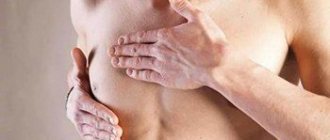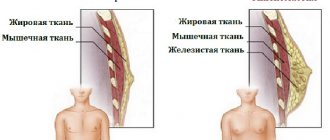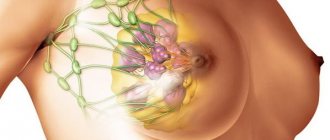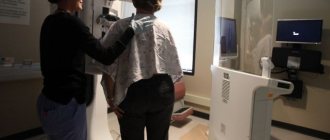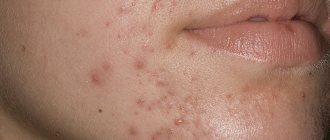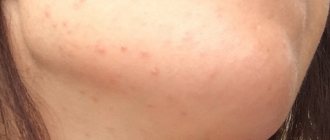Puberty is a difficult time in a person’s life. Sharp changes in psychological and physiological orientation occur. At this time, teenagers experience a rapid surge in hormonal levels, which affects their usual lifestyle. An additional burden on the body is represented by the activation and development of diseases due to the instability of the immune system and changes in the functioning of the body. Gynecomastia in adolescents is one of these pathologies.
Concept and characteristics
The described disease is represented by an enlargement of the mammary glands in boys. As for the severity of such a change, it differs significantly. In some cases, the breast changes slightly, and the deviation is detected only after examination by touch (palpation). But there are situations when the pathology has pronounced signs, and the gland significantly increases in size.
Pubertal gynecomastia usually appears between 12 and 15 years of age, but there are exceptions. At the moment, a hormonal change is occurring in the young man’s body, and he is turning from a boy into an adult man. The process of gland enlargement is often accompanied by psychological discomfort and emotional stress; help from adults is needed.
Leave breasts to women and be men!
Adolescent gynecomastia is not only a medical, but also a social problem. Female breasts in a young man can be a serious obstacle to the formation of his personality as a man. Sports activities, equal relationships with peers, and communication with the opposite sex can be difficult or even impossible for boys with gynecomastia. We know examples when teenagers became withdrawn, preferred “communication with the computer” to social contacts, fell into depression, lost motivation to study, develop physically and become men.
In addition to psychological complexes and social maladjustment, such adolescents experience poor posture. In an effort to hide women's breasts, they stoop for many years, which leads to curvature of the spine. Some young men are forced to bandage their breasts with elastic bandages or cover their areolas with a plaster. There is no point in hoping that gynecomastia will go away over time. It is impossible to get rid of breasts with the help of medications.
Reasons for development
Gynecomastia in a child with breast enlargement can be caused by changes in hormonal levels. In particular, estrogen (the female sex hormone) is significantly higher in level than testosterone (the male hormone). In turn, the cause of such abnormal development is the increased content of aromatase. This is an enzyme that ensures the intensive conversion of testosterone into the female hormone. As a result, gynecomastia of the mammary gland rapidly develops and progresses.
The indicated changes in adolescence are physiological in nature. In most cases, they go away on their own by the age of 17, sometimes a little later, if there are no complications or complaints from the growing boy.
Gynecomastia occurs against the background of various abnormalities and new diseases. In this case, the reasons stand out:
- pathologists of the liver, kidneys
- long-term use of medications included in the complex therapy of endocrine diseases, tuberculosis, depression
- the presence of malignant seals in the area of the ovaries, adrenal glands
- abuse of alcohol, drugs
- diagnosis of herpes zoster formed in the chest area
- autoimmune disorders
- chest injuries
- excess weight caused by metabolic disorders
Classification of the disease
It is worth noting that teenage gynecomastia can be false and true.
In the first case, an increase in adipose tissue on the mammary gland is detected, which contributes to their enlargement. This process occurs due to obesity.
True gynecomastia can be of the following types:
- Gynecomastia in newborns is diagnosed in newly born children. The reason is that maternal sex hormones entering the baby’s body during the prenatal period have an intense effect after birth.
- Juvenile gynecomastia occurs in almost half of growing boys. The reproductive system is intensively formed, disturbances are observed at the hormonal level, and as a result, the breasts increase in size.
- Pathology with enlargement of the mammary gland, observed in old age. In this case, reverse processes occur in the body of an adult man. Testosterone levels sharply decrease, estrogen is produced in excess.
It is also customary to distinguish gynecomastia depending on the severity of characteristic symptoms.
At the initial stage, the mammary glands enlarge slightly, which is almost imperceptible upon examination.
The second stage of gynecomastia occurs during the period of completion of breast maturation, the outlines of which are more pronounced. In such a situation, a malfunction occurs in the reproductive system, libido is significant, and sperm are produced in meager quantities.
In the final phase of gynecomastia, irreversible deformation processes occur, and the mammary gland area is overfilled with connective and fibrous tissue. The way out is surgical intervention.
As for the location of the disease, the disease in adolescents can be bilateral (symmetrical lesions) or unilateral (an increase in the size of only one breast). Most often, during puberty, men are diagnosed with bilateral mammary enlargement.
Diagnostics
With enlarged mammary glands, parents with a teenager usually turn to a pediatrician. After the initial examination and at the slightest suspicion of gynecomastia, the patient is sent to an endocrinologist. During the examination, the doctor determines true or false gynecomastia. The pathological form in most cases is found in every second child in the age category 2–12 years. The specialist determines the symptoms characteristic of heredity, signs of underdevelopment of the gonads. Often the symptoms indicate endocrine disorders, a hormone-producing tumor, etc.
If we talk about laboratory tests for enlarged mammary glands, they are presented in the following list:
- biochemical blood test for the presence of liver enzymes, creatinine
- blood test to determine hormonal levels over time (the patient must do it!)
- karyotyping - studying the chromosome set of a patient if genetic pathologies are suspected
Laboratory diagnostics are also performed, including MRI of the brain, CT scan of the adrenal glands, ultrasound of the testicles and mammary glands, and mammography.
Gynecomastia in men carries a many times greater risk of developing cancer compared to women. In this case, mammographic examination is mandatory.
Gynecomastia in adolescence
"Wait until you're 18..."
As a rule, parents of such children turn to an endocrinologist and are advised to wait indefinitely. This statement is paradoxical. If gynecomastia does not go away on its own within six months after its occurrence, it can no longer disappear. The growth of the rudimentary mammary gland is controlled by hormones, and it is estrogens that are responsible for this process. Figuratively speaking, the mammary glands do not care in which body they exist - male or female. They will behave as their hormones tell them to. That is, despite the fact that gynecomastia is a pathology in the male body, the growth of the mammary glands is a natural phenomenon in the event of an increase in estrogen levels. The formed mammary gland is essentially an organ that cannot disappear anywhere.
In our practice, there have been cases when desperate young people sought surgical help immediately after reaching adulthood due to a lack of mutual understanding with their parents, who were afraid to have surgery or hoped that gynecomastia would disappear.
Treatment methods
The appearance of lumps on the mammary gland in adolescence may indicate the development of various pathologies. In this case, the task of treatment is to eliminate the root cause of the disease.
The development of gynecomastia in 7-year-old boys is accompanied by physiological processes that go away on their own; medical intervention is not required. The recommendation for parents is constant monitoring and consultation with a specialist.
To get rid of pathological gynecomastia on the mammary gland, it is necessary to reduce the production of female steroids. This includes physiotherapy, nutritional correction, an active lifestyle, drug therapy, and, in extreme cases, surgery.
Possible complications and consequences
Teenage gynecomastia usually goes away within the first two years after it occurs. This pathology only causes psychological discomfort in the boy. Young men with this problem are sometimes embarrassed to go to the swimming pool, gym, or use shared locker rooms.
But in some cases, the disease can cause serious problems in the socialization of a teenager. An increase in the volume of the mammary glands, which persists and develops for more than a year, can provoke fibrosis - scarring of tissue in the affected area. This significantly complicates drug therapy.
In extremely rare cases, gynecomastia can cause the development of carcinoma, a very serious disease. Therefore, if you experience severe chest pain, dark discharge from the nipples, or swelling, you should immediately consult a doctor.
Is surgery necessary for gynecomastia in teenagers?
Gynecomastia in boys, accompanied by the formation of female-type breasts, entails serious aesthetic discomfort. In addition, the risk of developing dangerous complications increases, which is an indication for surgical intervention.
The operation is indicated in the following cases:
- The likelihood of malignant lumps appearing in the breast area.
- Gynecomastia is actively developing, the affected area greatly increases in size and begins to hurt.
- Condensed nodes in the chest area can be clearly felt.
- Genetic mutations caused by hormonal imbalance. In such a situation, there is a high risk of cancer.
- It was not possible to remove gynecomastia with medication; the pain remained.
§2. Until what age do breasts grow: exercises for breast enlargement
At what age do breasts begin to grow? Each female body is absolutely individual and unpredictable, and therefore it is impossible to predict the beginning and end of the development of the female breast.
On average, bust development begins at the age of 10-12 years. For some, development occurs a little earlier, at 9 years of age. For some, development may begin after the age of 13.
However, if at the age of 15-16 years a girl’s breasts do not begin to grow and menstruation does not begin, then she should consult a doctor. This situation can occur due to the lack of estrogen in the body and requires medical intervention.
Periods of breast growth
Exactly the same situation occurs with the end of breast growth. No one can say for sure until what age development will occur.
On average, bust growth ends at the age of 17-20 years. In some cases, breasts may stop developing as early as 24 months after they begin to grow.
Other experts believe that the end of breast development can be calculated mathematically. And just add 3-4 years to the beginning of development. This will be the end of breast development.
What influences changes in a woman's bust?
In general, a girl’s breasts change in size throughout her life, and constantly tend to change their development in different directions.
It can change not only at the cellular level, but also change externally. Constantly increasing and decreasing.
Some girls believe that their breasts begin to grow during the menstrual cycle, but this is a misconception. This is explained by the fact that many people's mammary glands change in size.
Progesterone, which is produced in the ovaries, affects the growth of the epithelium of the glands and leads to increased production of their hormone. And at the end of the menstrual cycle, progesterone loses its effectiveness and the breasts regain their usual breast volume.
Also, the breast may stop developing due to the physical condition of the body, namely due to stooping, scoliosis. Slouching leads to improper breast development.
Since women's breasts are greatly influenced by hormones, some experts believe that the age of onset of intimate life and pregnancy influences development.
Some girls notice that after pregnancy their breasts become larger, while for others, on the contrary, they become smaller. This can occur due to various processes occurring in the body and factors that can affect them.
Various diets and poor nutrition also affect the development of the bust. Girls should get all the most beneficial vitamins, proteins, fats, and carbohydrates from food. If the nutrition is not correct, the body may react in such a way that the breasts may stop developing altogether.
Heredity. If relatives had small breasts, then the girl’s breasts will be the same. And nothing can influence this.
Equipment. Most often, large or overweight girls have good breast volumes. Thin people, in turn, have a small bust.
Scientists also believe that the volume of a woman’s bust is also influenced by the environment. Southern girls have juicier breasts than girls from the north. Climate influences.
What to do for breast enlargement
Throughout a woman's life, breasts change in size and sometimes in shape. But to improve and tighten your breasts, you can still take some steps. And which ones, we will now discuss with you.
- Don't neglect to wear a bra. It supports the breasts and helps maintain shape.
- The diet must include such foods as: dairy products, red fish, beans, meat products, flax seeds, nuts, pumpkin, cereals.
- Posture. We don’t slouch, but straighten our shoulders and chest forward. This also applies to walking and sitting.
- And where are we without proper nutrition? We exclude harmful substances from the diet. Good food is the key to health and beauty.
- We train the pectoral muscle. The simplest and most effective exercise is push-ups. Of course, this will not increase breast size, if only visually, due to an increase in the pectoral muscle. But it will give a beautiful look to the décolleté area and improve the condition of the skin.
- Massage. It will help make your skin more elastic and beautiful, improve blood circulation. But before a massage course, you should visit a mammologist to avoid the development of hidden diseases. Now there are many different massages for the chest: Japanese, water, corrective, vacuum.
- Plastic surgery. Implants. To eliminate their complexes about small or shapeless breasts, women are ready to do a lot, even surgical intervention. Some people are afraid of the operation itself and the long recovery after it.
Conservative treatment
The patient can get rid of an enlarged mammary gland by taking hormonal drugs prescribed by the doctor. For testosterone deficiency, drugs containing it are used. An excess of estrogen requires taking medications that block its maturation.
If the cause of the development of gynecomastia is a separate disease of internal systems or organs, drug-based therapy is prescribed to eliminate alarming symptoms.
Diet
Proper nutrition cannot eliminate hormonal imbalances that lead to the development of pathology in the mammary gland. But it cannot be said that a balanced diet does not have a positive effect on the body with gynecomastia. If we are talking about a baby with suspected gynecomastia, you should not transfer him from breastfeeding to artificial formula due to the presence of lumps in the breast area.
Older boys should regularly consume:
- protein fortified foods
- porridge
- vegetable side dishes
- fresh herbs
It is strictly recommended to drink in the volumes required by the body, taking into account compotes, juices and plain water. It is unacceptable in the diet for breast enlargement to include fast food, large quantities of sweet baked goods, and sweets containing preservatives. It is recommended to consume foods enriched with zinc, fruit juices, and green tea to prevent gynecomastia. The diet should consist only of natural and maximally fortified dishes.
§1. Important questions about the female bust: how long do breasts grow, what affects the process
Until what age do breasts grow?
There is constant debate around the age at which women's breasts grow: some doctors and scientists claim that this process stops by the age of 20, others by the age of 16. But there is always a chance that your bust size will increase after pregnancy and breastfeeding. Breast growth is an individual factor that depends on many nuances: the girl’s hormonal background, the amount of subcutaneous fat, dietary habits, and others.
Some scientists even recognize a woman’s nationality as a factor in mammary gland growth. For example, indigenous women of Yakutia and Finland almost always have small breasts, but representatives of the Armenian and Georgian nationalities can boast of curvaceous figures.
Ideal female breast shapes
How breasts grow
Breasts do not grow constantly, but in periods - they can be clearly traced by the girl’s age, changes in certain years are visible even to others: the initial stage is 9 years, but only the first symptoms of changes can be felt (swelling, a feeling of heaviness, fullness), but by 16-20 most often you can already see the final shape.
Stages of breast growth
It is customary to distinguish 3 main stages of breast growth:
- 9-10 years - the beginning of the process, the girl’s breasts acquire rounded shapes;
- 12-16 years – a period of active growth, when changes occur every month;
- 15-16 years - according to statistics, growth stops in most cases.
Sometimes the increase in the size of the mammary glands can continue until the age of 20. This is also possible during pregnancy and breastfeeding, regardless of the woman’s age.
When do breasts start to grow?
Breast growth begins at the age of 9-10 years, but this is a conditional indicator - a girl may have an increased or decreased amount of estrogen in the body - a hormone that directly affects this process.
The beginning is easy to notice:
- the nipple becomes rough and protrudes;
- the areola enlarges, but does not change its color;
- A loose ridge forms in the lower part of the chest - this is where glandular tissue begins to grow.
Why breasts grow: main factors
What affects breast growth:
- Physiological parameters of the girl. If her weight is within the normal range and the girl is thin, then she is unlikely to have large breasts - there is a direct relationship between the size of the mammary glands and the subcutaneous fat layer in the chest area.
- Genetic predisposition. If a girl’s family includes women with small busts, then you should hardly expect a large size. On the contrary, if this happens, you should consult a doctor - uncontrolled, atypical growth may indicate the development of severe pathologies - for example, diseases of the endocrine system, oncology.
- Diet. Insufficient intake of microelements, proteins, fats and vitamins can lead to inhibition of breast growth. In some cases, it stops altogether - this is often found in teenagers who follow strict diets.
Doctors say that the bust grows evenly against the background of moderate, regular physical activity, with correct posture and the absence of spinal diseases (scoliosis).
Watch this video about when a girl’s breasts should form and what diseases can cause delayed sexual development:
What kind of breasts should a 16 year old have?
At 16 years old, the breasts should already be formed:
- round shape;
- smooth contour;
- non-protruding nipple;
- dark brown color of the areola.
This is conditional data, because some girls at this age still have active breast growth. You cannot rely on these indicators and you should not invent illnesses if you discover an irregular shape of the mammary gland or a light color of the nipple circle - this is not a deviation from the norm until the age of 20.
Structure of the mammary gland
What age do girls grow to?
Girls grow up to 23 years old. By this age, the figure is fully formed and the growth of the foot stops. But this does not mean at all that the mammary glands will increase until the specified age - they grow first, which is provided by nature - by the specified age, many become nursing mothers.
Data about the age of a girl’s final growth/formation “work” only if her health is impeccable - there are no deviations in the functionality of the endocrine system, she regularly plays sports, and so on.
How to understand that your breasts are growing
It is quite simple to understand that the breasts have begun to grow - signs of this process immediately appear; two stages are distinguished:
- pre-pubertal period;
- puberty.
Signs of breast growth in girls
The first signs of growth of the mammary glands in girls appear in the pre-pubertal period - 9-10 years: the nipple becomes engorged, its surface becomes hard/dense to the touch, and “grooves” appear. After 1-1.5 years, the glandular tissue begins to swell under the nipple, which makes it possible to palpate a small ridge.
As soon as the nipple and areola begin to rise slightly above the breast (“puff up”), we can assume that a period of active growth of the mammary gland has begun - changes will be noted literally every month. The girl does not experience any discomfort, but may complain of a feeling of fullness and heaviness in the mammary glands.
If your breasts grow quickly, should you worry?
Breasts can grow quickly for the following reasons:
- temporary hormonal imbalances – their formation occurs, the level of progesterone and estradiol fluctuates;
- there are diseases of the pituitary gland or hypothalamus;
- neoplasms of a benign or malignant nature in the ovaries;
- oncology with tumor localization in any organ or system of the body.
Hormones that affect breast growth
If rapid breast growth continues for more than 3 months, then you need to consult a doctor. You will need to undergo an examination and find out the true reason for this course of the mammary gland growth process. Even if pathologies are not diagnosed, the girl’s condition will need to be monitored, because rapidly growing breasts lead to the formation of irregular contours of the mammary glands and poor posture.
Why did my breasts stop growing?
Breasts may stop growing if:
- the girl’s body contains too small amounts of female estrogen hormones;
- there is a genetic predisposition - in the girl’s family, most likely, all women have small breasts;
- too limited nutrition - often observed when following strict diets (teenagers are especially fond of this);
- lack of vitamins;
- excessive mental stress;
- increased physical activity, performing hard work associated with heavy lifting.
Expert opinion Tatyana Somoilova Cosmetology expert If by the age of 15-16 a girl’s breasts do not grow, and the menstrual cycle is completely absent or occurs with constant disturbances, then you need to seek help from a gynecologist. Most likely, a lack of estrogen in the body will be detected - a condition that can be corrected with medications.
Can breasts grow after 20 years?
After 20 years, breasts can grow in size if the process of enlargement/formation of the mammary glands is too long due to heredity or relates to the individual characteristics of the body. The second option is carrying and giving birth to a child, feeding him: in this case, the growth of the mammary glands can be observed at any age.
Why do breasts keep growing?
It is believed that after 15-16 years a girl may not expect a sharp growth of the mammary glands, but in some cases the breasts continue to grow until the age of 20-23, sometimes it occurs in “waves” until the age of 40. This is facilitated by:
- the level of female hormones in the body;
- presence/absence of endocrine diseases;
- pregnancy;
- breastfeeding a baby.
How to stop breast growth in teenagers
It is impossible to stop the growth of mammary glands in adolescents. If we are talking about girls, then this is a natural process for their body. The only exception is a too rapid breast enlargement - a medical examination is required to determine the cause of this condition (they will most likely be pathological).
If the growth of the mammary glands is observed in boys, then we are talking about gynecomastia - a disease associated with puberty and the restructuring/formation of the hormonal system. What doctors recommend:
- undergo an examination and find out the level of functionality of the entire endocrine system of the teenager;
- control the growth of the glands, so that if it accelerates, contact specialists in time and exclude or diagnose a developing tumor at an early stage;
- Visit a psychologist with your teenager - it is important to maintain the child’s psycho-emotional state within normal limits and prevent complexes from developing.
Watch this video about who to contact and what examinations are required for breast diseases in children:
How to understand that breasts have stopped growing
You can tell that your breasts have stopped growing by the following signs:
- the mammary glands took an even shape - round;
- the chest contour is smooth, has no differences;
- the nipple and areola do not protrude above the surface and can “look” upward;
- the color of the nipple and areola has become brown (may have different shades, but they are all dark).
The most important indicator is that there is no need to regularly update a set of bras due to the inappropriate cup size.
Why do breasts grow with age?
After 20-23 years, breast growth stops, but with age, breasts can increase in size for the following reasons:
| Reasons for normal breast enlargement | What's happening? |
| Body weight increases | The mammary gland consists of adipose and glandular tissue and, naturally, with an increase in body weight and obesity, the fat layer in the mammary glands also grows - they literally “swell” and become lush. |
| Pregnancy | A restructuring of the woman’s hormonal system occurs, which leads to breast enlargement. An additional factor is the filling of the ducts with milk - growth is noted at the end of the gestation period. |
| Feeding the baby | The reason is banal - the mammary glands are filled with milk, after sucking it out, the breasts seem to “fall off”, but after a while they become lush and large again. |
| Hormonal changes | If there is an excess of prolactin, for example, the bust becomes “full”, as during pregnancy. |
Most of the reasons listed are natural. If these factors are excluded from a woman’s life, then the breasts will quickly return to their previous size. The only caveat is that during a rapid and “unauthorized” enlargement of the mammary glands, a sharp stretching of the skin occurs, which contributes to the formation of stretch marks. In the future they remain, which causes sagging breasts.
At the age of 30-50 years, there is a high risk of developing tumors in the mammary glands, so their enlargement without obvious reasons should be the reason for a visit to the doctor. It is also important to visit a specialist if your breasts hurt, become engorged, or there are other reasons to suspect a hormonal imbalance.
Watch this video about the structure of the mammary gland and risk factors for the development of cancer processes in it:
What can cause breasts to grow?
There are a number of “events” that can cause breasts to grow:
- special exercises;
- specific diet;
- massage and other physiotherapeutic procedures.
Doctors are quite skeptical about these methods of mammary gland enlargement - there are too many disadvantages, although there are also advantages from the manipulation.
Nutrition: will cabbage, beer help?
To speed up breast growth, your menu should include:
- peas, lentils and other legumes;
- nuts (preference – walnuts);
- fish is not fatty and from the “red” category;
- liver - poultry, pork, beef;
- milk;
- pumpkin seeds;
- flax seeds;
- cheese - soft varieties such as Adyghe and tofu are especially useful.
Of course, these products do not “directly” affect breast growth, but they contain folic acid and phytoestrogens, which will have a beneficial effect on the process of formation of the mammary glands.
There is an opinion that breasts will actively grow if a woman eats a lot of cabbage and drinks beer. Here's what doctors think about this:
- cabbage contains phytoestrogens, which prevent the development of mastitis;
- this vegetable maintains the tone of the skin, which ensures the preservation of the shape of the breast;
- beer enlarges the mammary glands only in men;
- A foamy drink leads to an increase in body weight, which, naturally, will ensure the acquisition of curvaceous breasts.
In terms of growth and enlargement of the mammary glands, beer and cabbage are absolutely useless products.
Exercises
Directed physical activity makes the breasts more toned, improves the tone of the skin on them, and visually they become much larger in size. But in fact, breast enlargement really only occurs visually - physical exercise works the muscle tissue that is located above the chest. They become strong, elastic and “pull” the mammary glands up. The simplest exercises are:
- Push ups. They can be performed from the floor, from a chair, or even from the wall - as convenient.
- Wave your arms. You definitely need to pick up dumbbells, swings are performed forward and backward, you can spread your upper limbs to the sides, lift them up.
- Pull-ups. Performed from a horizontal bar, you can be in a hanging position or reclining.
A set of physical exercises does not need to be performed daily - muscles grow in the breaks between workouts, so three times a week will be enough. Every day it is worth performing the “prayer” exercise:
- sit on a chair, straighten your back;
- place your hands in front of you, bend your elbows and bring your palms towards each other - as if a prayer is beginning;
- during a deep breath, begin to press your palms towards each other, offering resistance;
- after 5-10 seconds, exhale deeply and relax your upper limbs, moving your palms 5 cm apart from each other.
A set of exercises to strengthen the chest muscles
The listed exercises not only strengthen the muscles, but also contribute to the formation of correct posture, which is also “responsible” for the size and appearance of the breasts. When the back is straight, the mammary glands take the correct position.
Massage: pros and cons
Breast massage is carried out 2-3 times a week. Stroking, rubbing, patting and circular movements are performed slowly and effortlessly at first, gradually accelerating and pressing on the chest. As a result of this procedure, blood circulation increases, lymph flow improves, excess fluid is removed from cells, and skin tone increases. Together, this gives the effect of enlarging the mammary glands.
During the procedure, you can and should use cosmetic oils - the massage will take place without any discomfort for the woman, and additional nutrition will be provided to the breast cells.
Many doctors are against massage because it can provoke the active growth of tumors and breast cysts. Even if the neoplasms are microscopic in size, after shaking and heating they begin to pose a threat to the health and life of a woman.
Sex and hormones
French doctors claim that regular sex promotes breast enlargement.
They argue that sex provokes a sharp release of the hormone estrogen in the body, which causes the growth of the mammary glands. This theory has not received official confirmation.
As for taking hormonal drugs, those women who use birth control pills note an increase in the size of the mammary glands by 1-2 sizes.
But there is no need to rejoice - this is a side effect of long-term use of hormonal drugs and serves as a reason to change the contraceptive.
In addition, some hormonal pills provoke the formation of tumors in the tissues of the mammary glands, which can transform from benign to malignant.
Do mammary glands grow during menstruation?
Breast volume increases during menstruation, but there is no true growth of the mammary glands. This is easy to explain: before and during menstruation, a woman’s body intensively produces progesterone. It increases the volume of glandular tissue. After the bleeding stops, the level of progesterone decreases, and the glandular tissue returns to its usual size.
At what age can you have breast enlargement?
Any clinic provides breast augmentation services from the age of 18, but the general state of her health must be taken into account:
- are there any abnormalities in the functioning of the endocrine system;
- whether the formation of the body and mammary glands has been completed;
- whether the breasts continue to grow.
Lipofilling of the mammary glands
Formation of mammary glands during pregnancy
All the changes that occur in a woman’s mammary glands during pregnancy are aimed at ensuring long-term lactation, and this is what happens:
- from the first days of conception, the breast begins to be actively supplied with blood - blood flow increases, tissue cells receive a sufficient amount of oxygen and nutrients;
- tissue of the milk ducts grows;
- the lobules of the mammary glands increase in volume;
- fatty patches appear in the breast tissue in the 2nd and 3rd trimester of pregnancy.
By the end of pregnancy, the mammary glands increase in size by at least 2 sizes, but this does not happen for everyone - heredity plays a role.
Breast growth at a young age is a natural process that should be controlled by the girl and her parents. Adult women should know the reasons for breast enlargement at 30-40-50 years old - you can seek qualified medical help in time. By following the recommendations of experts, you can visually make your breasts large and lush.
Exercises
At the early stage of gynecomastia, the production of male hormones is activated with the help of physical activity. In addition, regular activity helps stabilize weight, this is important when the mammary gland increases in size.
At home, regular push-ups will be useful, removing fat cells in the problem area and helping to build muscles in the upper extremities. Raising and bringing your arms together with dumbbells in a lying position will help bring the mammary glands into proper shape.
For simple exercises to be beneficial, you need to take classes under the guidance of a trainer. He will develop an individual set of classes designed for a specific teenager with existing health problems.
Folk remedies
Gynecomastia cannot be treated only at home without the use of complex medical therapy. Herbal medicine is carried out subject to compliance with all doctor’s instructions:
- A powerful anti-inflammatory agent is thyme decoction. The dry composition (2 tablespoons) is brought to a boil in 500 ml of water, simmered for 5 - 7 minutes. Dosage: 100 ml 3 times a day immediately before meals.
- Herbal collection with ginseng for gynecomastia. Take licorice root, raspberry leaves, eleutherococcus, and ginseng in equal parts. Infuse 1 tbsp in 400 ml boiling water. l. collection for 3 hours. Reception: 2 - 3 spoons before meals.
Treatment of gynecomastia in adolescents 12-15 years old is a comprehensive measure aimed at eliminating the causes that led to the development of the disease and preventing its development. In accordance with the diagnosis, the method by which it is necessary to treat the disease is selected. During puberty, it is important to monitor your health and seek medical help if there is the slightest deviation in the development of the mammary gland.
